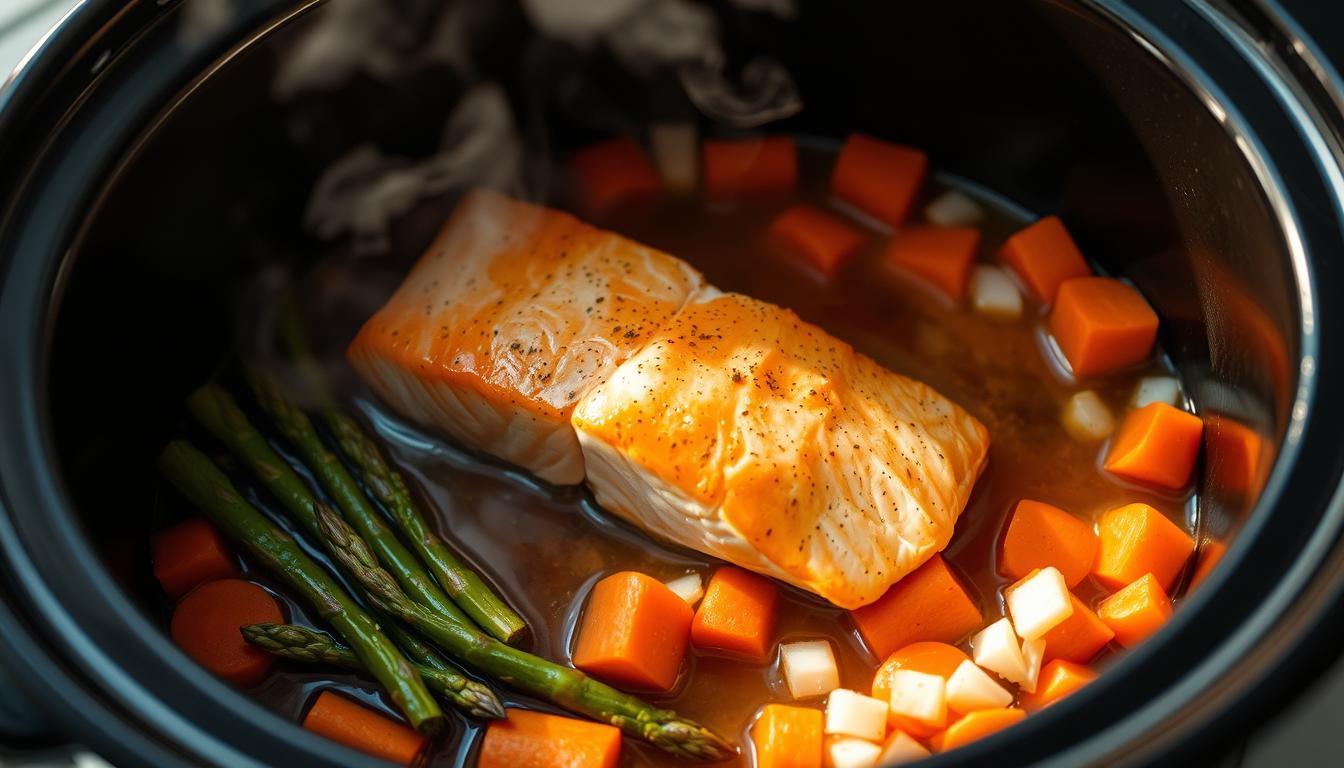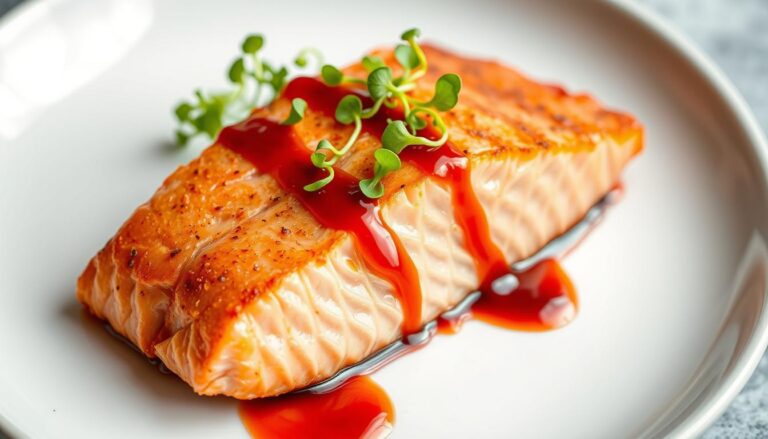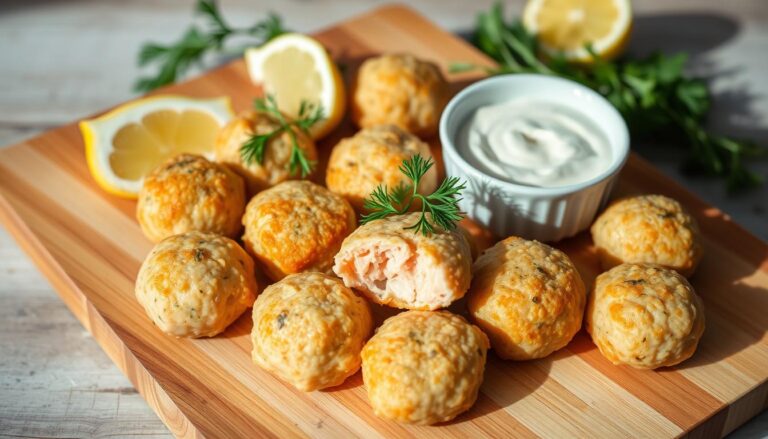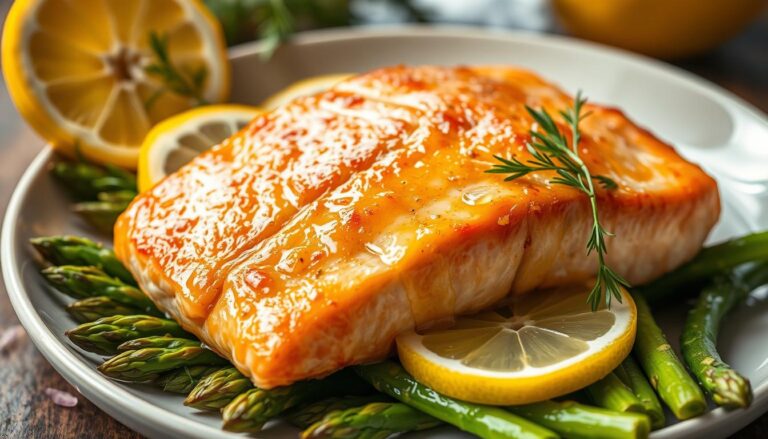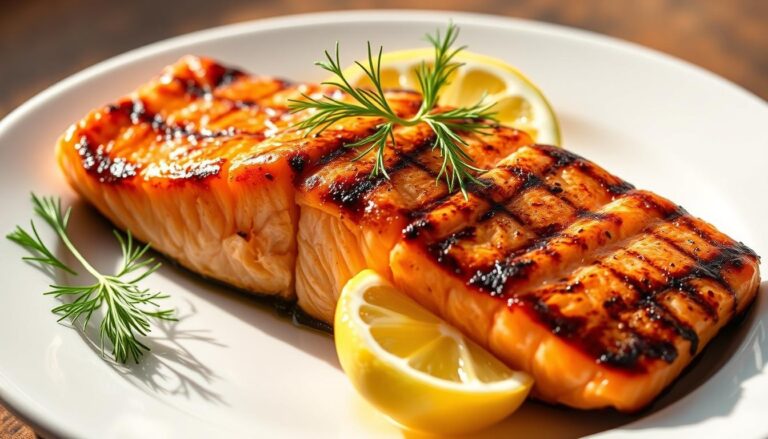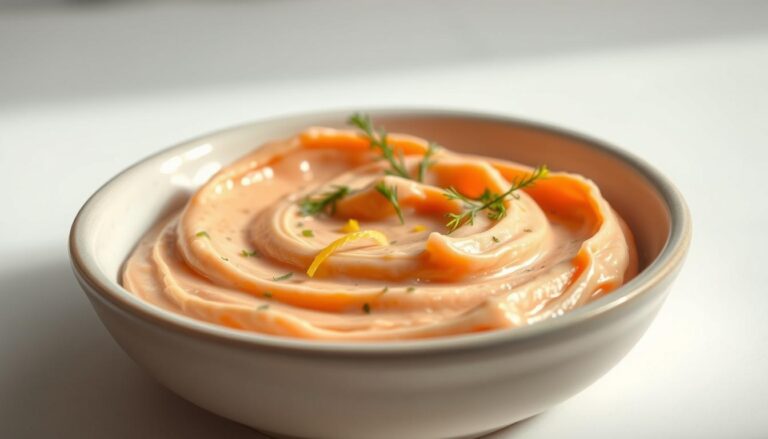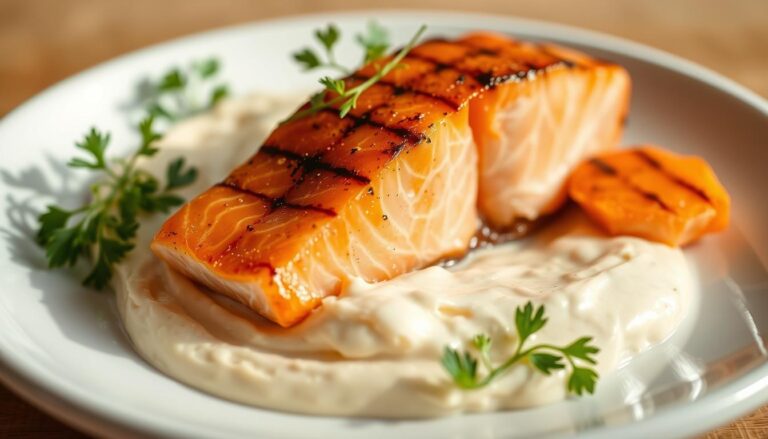Slow Cooker Salmon: Effortless Meals for Any Night
Ever stared into your kitchen at 6 PM, feeling tired and wanting a healthy dinner? Slow cooker salmon is here to save the day. These recipes turn dinner into a breeze, making it easy to fit into your busy schedule.
Imagine walking into a kitchen filled with the smell of herbs and perfectly cooked fish. It’s tender, flaky, and full of flavor. Easy salmon meals are now a reality. With just a little prep, slow cooker salmon brings gourmet food to your table without the hassle.
Table of Contents
Slow cooker salmon is perfect for anyone with a busy life. It’s not just for working pros or parents. It’s for anyone who wants tasty meals without spending hours in the kitchen.
Key Takeaways
- Slow cooker salmon provides convenient, nutritious meals
- Minimal preparation required for restaurant-quality results
- Perfect solution for busy individuals and families
- Consistently tender and flavorful fish every time
- Versatile cooking method adaptable to multiple flavor profiles
Understanding the Art of Slow-Cooked Salmon
Slow cooking salmon turns simple dishes into amazing meals. This method makes seafood tender and flavorful with little effort.
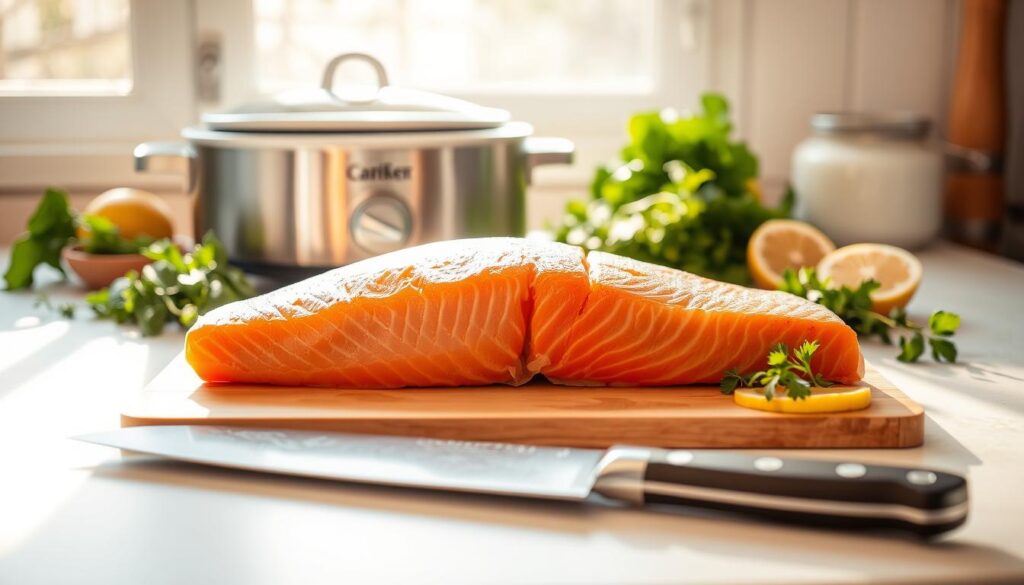
Exploring salmon dinner ideas? Knowing the science of low-temperature cooking boosts your skills. High-heat cooking can make fish dry and tough. But slow cooking salmon changes that.
The Science of Protein Transformation
Cooking salmon slowly breaks down proteins. This makes the fish incredibly soft and keeps nutrients intact. The low, steady heat cooks evenly without losing important nutrients.
- Proteins relax instead of tightening
- Moisture remains locked inside the fish
- Flavors develop more deeply
- Nutrients are better preserved
Temperature Control Essentials
Getting the temperature right is key for perfect salmon. Ideal slow cooking temperatures range between 135-145°F. This keeps the fish from getting overcooked and ensures it’s safe to eat.
Timing Matters
Most salmon dishes need 1-2 hours of slow cooking. Thinner pieces cook quicker, while thicker ones take longer to get flaky.
Essential Equipment and Preparation Tips
Preparing salmon in a slow cooker needs the right tools and techniques. This ensures your slow cooker fish recipes turn out delicious. The right approach to salmon filets and cooking methods is key.

First, pick the right slow cooker. A 6-quart oval slow cooker is best for salmon filets. It provides enough space for even cooking. Here are the essential items you’ll need:
- Oval slow cooker
- Heavy-duty aluminum foil
- Kitchen tongs
- Instant-read meat thermometer
- Sharp fillet knife
Foil packet salmon makes cooking easier and prevents sticking. Cut large sheets of foil to wrap each salmon filet. This method keeps flavors in and makes cleanup easy.
| Salmon Type | Best Cooking Method | Fat Content |
|---|---|---|
| Farmed Salmon | Slow Cooker | Higher (More Tender) |
| Wild-Caught Salmon | Careful Monitoring | Leaner |
Pro tip: Pat your salmon filets dry before seasoning for the best texture in your slow cooker fish recipes. This step helps prevent excess moisture and ensures seasonings stick well to the fish.
When preparing your salmon, choose fresh cuts with bright color and firm texture. Remove any pin bones with tweezers. Also, trim dark areas for a better presentation.
Selecting the Perfect Salmon for Slow Cooking
Choosing the right salmon is key to a great crock pot fish meal. The quality and type of salmon greatly affect the taste and nutritional value of your dish. It’s important to pick wisely to impress your guests.
Not all salmon is the same. Wild-caught and farmed salmon have different flavors and nutritional values. Your choice can make a big difference in your dish.
Wild-Caught vs. Farmed Salmon Options
Wild-caught salmon has a richer flavor and more omega-3s. These fish live in their natural habitat, making their meat leaner and tastier. Farmed salmon, while easier to find, has a milder taste and different texture.
- Wild-caught salmon: Richer flavor, more nutrients
- Farmed salmon: More readily available, consistent quality
Quality Indicators to Look For
When picking salmon for your slow cooker, look for these signs of quality:
- Bright, consistent color without brown spots
- Firm flesh that springs back when touched
- Fresh, clean ocean smell
- Minimal liquid in the packaging
Portion Size Guidelines
For the best results, use salmon fillets of 6-8 ounces per person. If using frozen fillets, thaw them in the fridge first. This ensures even cooking and the right texture.
Basic Slow Cooker Salmon Recipe
Making easy salmon meals in your slow cooker is simple. This basic recipe will change your dinner plans with little effort and lots of taste.
Begin by picking fresh, even-thickness salmon fillets. Your slow cooker salmon prep involves a few steps for perfect results every time.
- Select 4-6 oz salmon fillets
- Pat fish dry with paper towels
- Season generously with salt and pepper
- Optional: Add lemon slices or herbs
Cooking times for salmon in a slow cooker vary by fillet thickness. Thin fillets need 20-25 minutes, while thicker ones might take up to 28 minutes.
| Salmon Type | Cooking Time | Recommended Temperature |
|---|---|---|
| Wild-Caught Salmon | 20-22 minutes | 145°F |
| Farmed Salmon | 25-28 minutes | 145°F |
Pro tip: Your salmon is done when it flakes easily with a fork and feels slightly firm. Don’t overcook it to keep the fish moist and tender.
Marinades and Seasoning Combinations
Start making your salmon dinner ideas better with the right marinades and seasonings. The secret to amazing salmon dishes is knowing how to mix flavors. Your slow cooker is a place to try new taste combinations that make salmon dishes stand out.
Creating the perfect marinade is about finding the right mix of ingredients. These ingredients should enhance salmon’s taste. Let’s look at some great seasoning ideas that will change your salmon dinner game.
Classic Herb and Citrus Blends
Traditional marinades really highlight salmon’s flavor. Here are some classic mixes to try:
- Lemon and dill: A fresh taste that balances out the fish’s richness
- Rosemary and garlic: Strong herbs that add a rich flavor to your salmon
- Thyme and orange zest: A light, aromatic mix
Asian-Inspired Flavor Profiles
Try these Asian-inspired marinades for a unique taste:
- Soy and ginger: A savory option for your salmon
- Miso and honey: A sweet and savory mix that caramelizes well
- Teriyaki with sesame: A favorite flavor mix
Mediterranean Seasoning Options
Mediterranean flavors add a fancy touch to your salmon:
| Ingredient | Flavor Profile | Pairing Suggestions |
|---|---|---|
| Capers | Briny and tangy | Serve with roasted vegetables |
| Olives | Rich and salty | Pair with quinoa salad |
| Sun-dried tomatoes | Intense and sweet | Complement with herbed couscous |
Each marinade gives your salmon a special flavor. It turns simple fish into a memorable meal. Try these mixes to find your favorite healthy salmon dishes that will wow everyone.
Preventing Common Slow Cooker Salmon Mistakes
Cooking salmon in a slow cooker can be tricky. Many home cooks struggle to get the perfect texture and flavor. Knowing common mistakes helps you make delicious, perfectly cooked salmon every time.
Temperature control is key when cooking slow cooker fish recipes. The FDA says to cook salmon to 145°F for safety. Here are mistakes to avoid:
- Overcooking: Salmon cooks fast in a slow cooker. Check it after 1-2 hours to avoid dryness.
- Incorrect liquid ratio: Too much liquid makes salmon soggy, too little can burn it.
- Ignoring fish quality: Always use fresh salmon for the best results in cooking salmon in a slow cooker.
Managing moisture is crucial when cooking slow cooker fish recipes. Use a thin layer of liquid and add:
• Lemon slices
• Herb sprigs
• Butter or olive oil
Pro tips for perfect slow-cooked salmon:
- Line your slow cooker with parchment paper for easy cleanup
- Use a meat thermometer to check internal temperature
- Let the salmon rest for 5 minutes after cooking
Remember, gentle heat and careful monitoring are key when cooking delicate fish in a slow cooker. With practice, you’ll master the art of creating tender, flavorful salmon that’s sure to impress.
Side Dish Pairings and Serving Suggestions
Creating the perfect salmon dinner is more than just the fish. The right sides can turn a simple meal into a feast for the senses. They make your meal both healthy and visually appealing.
Choosing the right sides can take your slow cooker salmon from good to great. It’s all about matching flavors, textures, and nutrition.
Vegetable Accompaniments That Shine
Vegetables are key to a balanced salmon dinner. Here are some bright choices:
- Roasted asparagus with lemon zest
- Steamed broccoli with garlic butter
- Sautéed spinach with pine nuts
- Honey-glazed carrots
- Grilled zucchini with herbs
Grain and Starch Companions
Pair your salmon with these filling grains and starches:
| Grain/Starch | Preparation Style | Flavor Profile |
|---|---|---|
| Quinoa | Herb-infused | Light and nutty |
| Brown Rice | Coconut-cooked | Rich and creamy |
| Sweet Potatoes | Roasted with rosemary | Earthy and sweet |
| Couscous | Mediterranean-style | Light and fluffy |
Make your dish look as good as it tastes. Place your salmon in the middle, with colorful veggies and grains around it. Garnish with fresh herbs for a touch of class.
Storage and Leftover Management
Keeping your tasty salmon filets fresh after slow cooking is key. You can store and enjoy crock pot fish in several ways. This ensures you make the most of your meal prep.
Here are the must-know tips for storing leftover salmon:
- Cool salmon completely before refrigeration
- Use airtight containers to maintain freshness
- Refrigerate within two hours of cooking
- Consume within 3 days for optimal taste and safety
Proper storage techniques are vital for keeping your slow-cooked salmon fresh. Wrap your salmon filets tightly in plastic wrap or use sealed containers. This helps prevent moisture loss and stops bacterial growth.
Reheating leftover salmon needs gentle care. Don’t use the microwave, as it can dry out the fish. Try these methods instead:
- Warm in oven at low temperature (275°F)
- Use steaming method for moisture retention
- Add a splash of broth to prevent drying
Getting creative with leftovers can make your crock pot fish even better. Use cold salmon in salads, sandwiches, or pasta dishes for quick, tasty meals.
Freezing is a good option for longer storage. Wrap salmon filets in freezer-safe paper, removing air as much as you can. Frozen salmon stays good for up to 3 months if sealed well.
Conclusion
Exploring slow cooker salmon opens a world of tasty and healthy meals. Your kitchen can become a place of simple yet elegant cooking. This method makes it easy to prepare salmon that’s both nutritious and flavorful.
Learning about slow cooking shows how easy it is to make top-notch meals at home. By mastering temperature control and choosing the best salmon, you’ll get better at cooking fish. This journey leads to healthier and more enjoyable meals.
Salmon is a nutritional powerhouse, full of omega-3 fats, protein, and vitamins. Your slow cooker helps keep the fish’s texture and flavor perfect. Whether you’re new to cooking or experienced, slow cooker salmon makes it easy to create memorable meals.
Start using this technique to make your meals more diverse and nutritious. Your kitchen is ready to turn simple ingredients into amazing dishes that are good for you and delicious.

